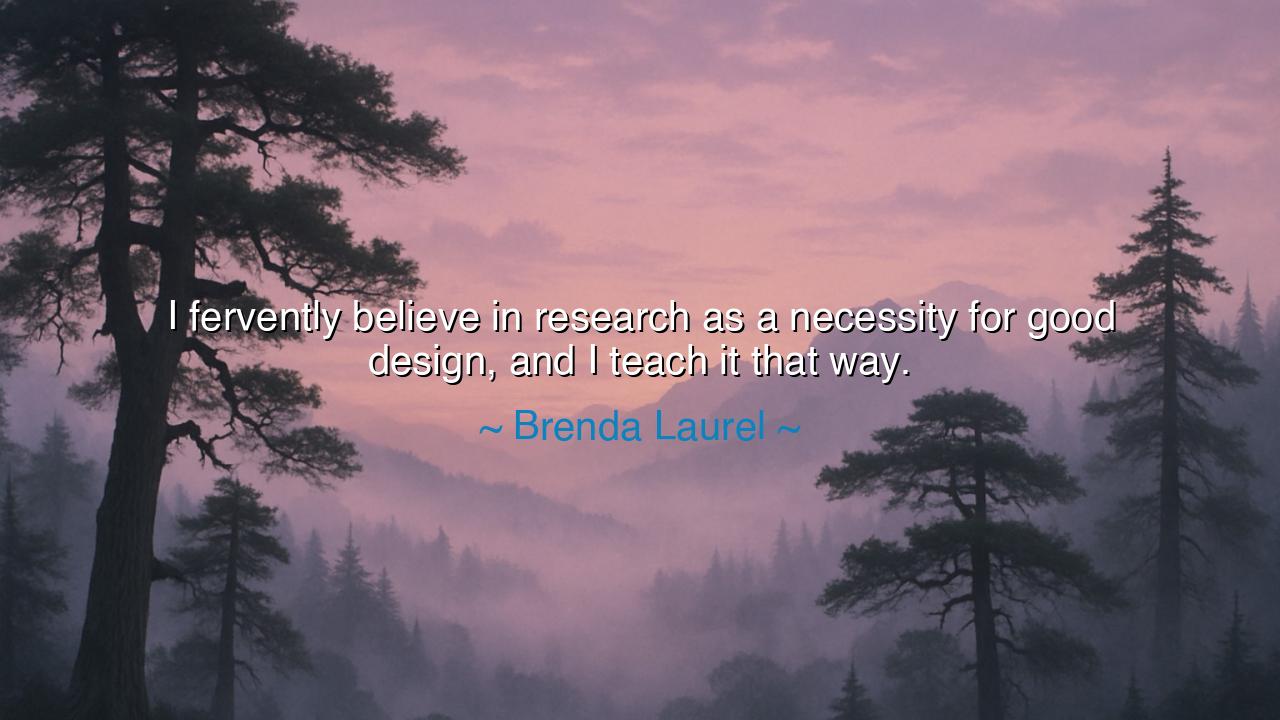
I fervently believe in research as a necessity for good design
I fervently believe in research as a necessity for good design, and I teach it that way.






“I fervently believe in research as a necessity for good design, and I teach it that way.” Thus declared Brenda Laurel, a pioneer of interactive design, scholar of human-computer interaction, and one of the great visionaries who bridged art and science in the digital age. In this single sentence lies a truth that echoes through the ages: that wisdom must precede creation, and that no design—no act of making—can truly serve humanity unless it is born from understanding. To research is to listen before speaking, to observe before shaping, to seek truth before daring to create beauty.
When Laurel speaks of research as a necessity for good design, she calls us back to an ancient principle, one that governed both the artisans of Greece and the engineers of Rome. For the wise have always known that creation without knowledge is chaos. The architect who builds without studying the soil will see his temple fall; the physician who heals without study brings harm. In the same way, the designer who creates without research—without understanding the needs, dreams, and behaviors of people—builds only illusions. To design well, one must first learn deeply, not from theory alone, but from the living world.
Brenda Laurel herself walked this path. In her work at the intersection of technology and design, she saw how machines could either liberate or limit human expression. She did not accept the cold sterility of early computing; instead, she sought to make interfaces that spoke to emotion, story, and play. Through her research in human-computer interaction, she discovered that technology must serve humanity, not the reverse. Her designs and her teachings flowed from one great conviction: that before we create for others, we must understand them. Her research was not a dry exercise—it was an act of empathy.
This belief finds its mirror in the story of Leonardo da Vinci, who, centuries before, spent years studying anatomy, light, and motion before painting his masterpieces. To paint the human form, he dissected the human body; to depict flight, he studied the wings of birds. Leonardo’s art was not born from imagination alone, but from observation and research, from the reverent study of nature. His genius lay not only in his creativity but in his discipline—the union of curiosity and method. So too does Laurel teach that research is not a cage around creativity, but the foundation that allows it to soar without collapsing.
Laurel’s words also challenge the illusion that inspiration alone is enough. In the modern world, where speed is worshipped and trends change by the hour, many seek to design by instinct alone. But instinct unguided by inquiry leads to error, and passion untempered by knowledge leads to waste. The true designer, like the philosopher or the craftsman, must cultivate patience—the patience to learn, to question, to test, and to fail. For good design is not born in a single flash of brilliance, but through the slow refining fire of research and reflection.
Yet in her phrase “I teach it that way,” Laurel reveals another truth: that wisdom must be passed down, not hoarded. The master’s duty is to guide the apprentice, to teach them that research is not drudgery but discovery, not restraint but revelation. Through learning, we honor those who came before us and prepare the ground for those who will follow. To teach the necessity of research is to preserve the lineage of mindful creation—a chain that binds the craftsman of old to the designers of the digital future.
So, my listener, take this lesson to heart: do not create in haste. Before you build, seek to know. Before you draw, observe. Before you speak, listen. Let research be your compass, guiding you through uncertainty toward clarity. Look not only at what people say, but at what they feel; study the hidden patterns of life, for therein lies the seed of true design. The designer who listens deeply creates not for an audience, but for humanity itself.
Thus, remember the wisdom of Brenda Laurel: that research is not a burden, but the root of all beauty and function. To design without it is to wander blindly; to embrace it is to join the eternal tradition of thinkers and makers who serve both truth and imagination. Be fervent in your seeking, patient in your learning, and humble in your creating. For through knowledge comes empathy, through empathy comes vision, and through vision—the kind that understands as well as invents—comes the kind of design that does not merely decorate the world, but transforms it.






AAdministratorAdministrator
Welcome, honored guests. Please leave a comment, we will respond soon